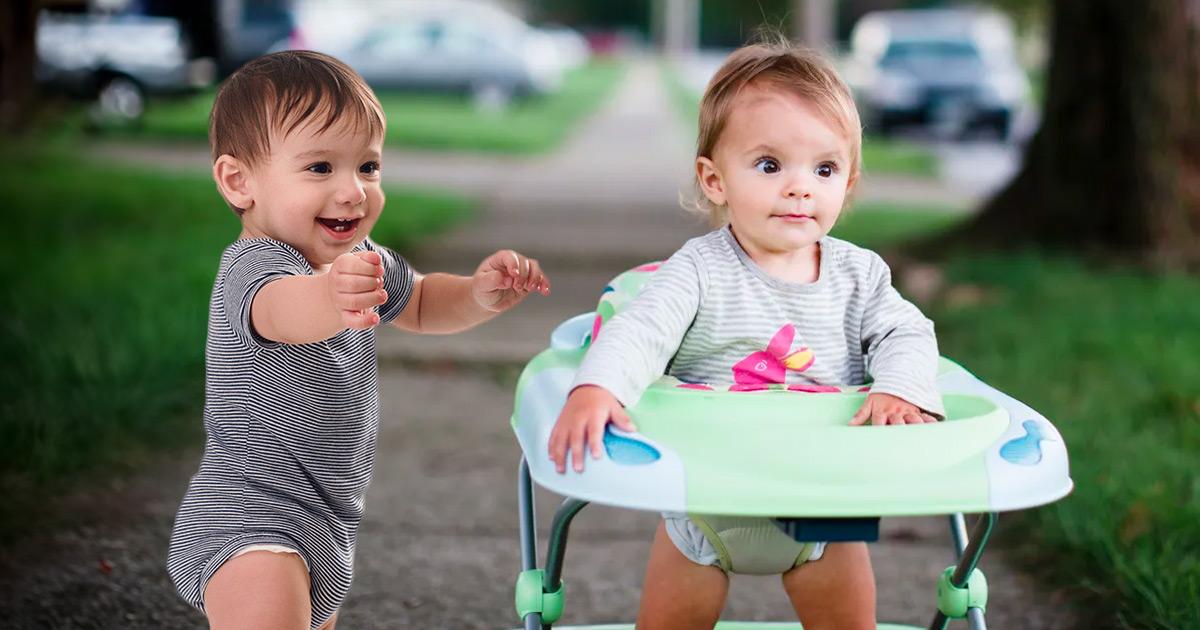What Are The Baby Walker’s Pros And Cons? Is It Safe To Get One?

Baby walkers have gained widespread popularity among parents worldwide as they assist their little ones during the initial phases of walking. These devices, equipped with wheels and a supportive seat, allow babies to move around while still developing their walking skills. However, the use of baby walkers has been a topic of debate among parents and experts. Are they beneficial for a child’s development, or do they pose potential risks? In this article, we will explore its true purpose, discuss the baby walker’s pros and cons, and help you decide whether getting one is the right choice for your baby.
What Is A Baby Walker?
A baby walker is a portable contrivance created to provide assistance to infants in the process of learning to walk. Typically, it consists of a padded seat surrounded by a frame with wheels attached to the base. The seat allows the baby to sit comfortably while their feet touch the floor, enabling them to move around with the help of their legs.
The Purpose of a Baby Walker
The primary purpose of a baby walker is to encourage mobility and independence in infants who are not yet capable of walking on their own. It allows babies to explore their surroundings and provides them with a sense of freedom. Baby walkers often come with interactive toys and colorful elements, making the experience entertaining and stimulating for the child.
What are the Advantages and Disadvantages of Baby Walker
In this section, we will explore the various baby walker pros and cons
Advantages of Baby Walkers
1. Increased Mobility and Independence
Baby walkers grant infants the chance to move freely, fostering a feeling of independence and curiosity. As babies push themselves forward with their feet, they can explore different areas of the house and interact with their surroundings in a way they couldn’t before. This newfound mobility allows them to be more curious and engaged with their environment.
2. Entertainment and Stimulation
Numerous baby walkers are designed with integrated toys, vibrant buttons, and interactive elements that engage the baby’s interest. These stimulating elements can enhance a child’s cognitive development and sensory exploration. The toys and activities also encourage the baby to interact with the walker, making the experience enjoyable and playful for the little one.
3. Parental Convenience
One of the significant advantages of baby walkers is that they offer parents a moment of respite. As babies occupy themselves with the toys and activities on the walker’s tray, parents can attend to other tasks, such as cooking, cleaning, or working, with some assurance that their baby is safe and entertained.
4. Muscle Strength and Coordination
Using a baby walker can contribute to the development of a child’s leg muscles and overall coordination. As the baby propels the walker forward, they engage their leg muscles, promoting strength and flexibility. This can be beneficial for preparing them for the transition to independent walking.
Disadvantages of Baby Walkers
1. Delayed Walking Development
One of the main concerns associated with baby walkers is that they may delay a child’s natural development of walking skills. The artificial support provided by the walker can differ significantly from the balance and muscle control required for independent walking. As a result, some babies may become dependent on the walker and not get enough opportunities to practice walking without support.
2. Safety Concerns
Baby walkers can present safety risks, especially when not used under proper supervision. Babies in walkers can move quickly, leading to potential collisions with furniture, walls, or objects, which may cause injuries. Moreover, access to stairs, pools, or other hazardous areas can be dangerous if not properly secured.
3. Hindrance in Crawling
Crawling is a crucial developmental milestone that helps babies strengthen their upper body muscles, improve hand-eye coordination, and develop spatial awareness. The use of baby walkers may discourage crawling as babies opt for the easier option of walking in the walker. This could potentially hinder their overall motor development.
4. Abnormal Walking Style
Some babies who spend significant time in baby walkers may develop an abnormal walking style, such as walking on their tiptoes. This gait pattern can impact the proper development of their Achilles tendon and balance, leading to potential orthopedic issues in the long run.
Should You Get Your Baby One?
When considering whether to get a baby walker for your child, it’s essential to weigh the advantages and disadvantages carefully. While baby walkers can provide entertainment and short-term convenience, the potential risks associated with delayed walking development and safety concerns must not be ignored.
If you decide to use a baby walker, follow these guidelines to ensure your baby’s safety and well-being:
- Supervision – Always supervise your baby when using a walker to prevent accidents and injuries. Maintain vigilant supervision over their activities and prevent them from reaching unsafe zones.
- Limited Usage – Moderation is key when using a baby walker. Avoid prolonged periods of walker usage and provide ample floor play and tummy time for your baby to develop their motor skills naturally.
- Safety Measures – Choose a baby walker with safety features such as wheel locks and seat belts to provide extra security for your child during use.
- Safe Environment – Establish a secure setting for your baby’s walker playtime. Block access to stairs, pools, or any other potential hazards to avoid accidents.
- Ultimately, the decision to get a baby walker should be based on your child’s individual needs and developmental stage, and always prioritize their safety and healthy motor development.
Bottom Line
There are pros and cons to baby walkers for a child’s development. While they offer increased mobility and entertainment, they may also delay natural walking and hinder crawling. To make an informed decision, consider your child’s age, safety concerns, and individual needs. Remember, parental supervision and providing a safe environment are key to ensuring your baby’s well-being during their explorations in a baby walker.
